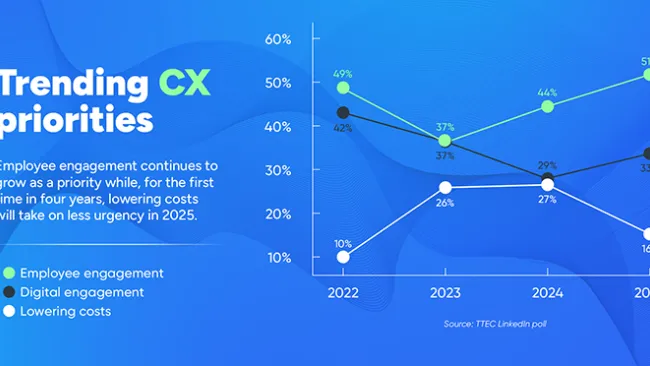The contact center: it’s an organization’s single greatest opportunity to grow a relationship with a customer. But it isn’t always treated that way.
The landscape of customer experience is evolving rapidly, with support becoming increasingly digital and omnichannel-focused. The contact center remains at the crux of it all – and yet too many brands miss the mark by failing to align customer experience (CX) with the contact center.
Traditionally, CX and the contact center operation have been siloed, guided by different priorities and different leadership. Contact center teams are largely operationally minded, while CX teams bring together more varied backgrounds from areas such as marketing, communications, and customer success.
But to succeed in the experience economy when every customer interaction matters, organizations need to make their contact center the “control hub” of their customer experience if they want to stand out. This is where customer experience promises made turn into promises kept.
When companies focus too much on CX, they tend to lose sight of the contact center, and vice versa. Instead of this micro-focused approached, the contact center should be viewed as the CX control hub because it gives valuable, actionable, real-time insights into what’s really happening when customers interact with a brand and organization.
To visualize how a control hub functions, think about a flight. The flight itself is the experience you consume, but the tools, skills and resources needed to deliver that experience are significant. There’s the cockpit (the control hub) as well as the pilot who’s in charge of leveraging the cockpit and their skills to deliver a great experience (associates). If our associates are the pilots of the experience we provide out of the contact center, we must equip them with the best cockpit to ensure a smooth flight. Associates sent into flight with too narrow visibility may provide an experience that falls short, whereas those with crisp visibility into the customer’s journey, history and relationship with the organization can provide a personalized and effective experience on the customer’s channel of choice.
Here are 7 ways to transform a contact center into a control hub.
1. Know the customer journey
Associates must be able to see and understand the entire customer journey. They need to know what customers have gone through, including previous interactions with a brand, if they are going to have the empathy and understanding to deliver personalized and meaningful experiences.
Many insights come out of understanding how customers flow through the touchpoints of a journey. By learning where there is tension during certain touchpoints, for instance, companies can isolate that volume on lower-cost-to-serve channels, saving money and improving customer satisfaction (CSAT) by meeting customers on their preferred channels.
Bring other departments beyond the contact center into this holistic discussion about the customer journey, too. Often, marketing or digital initiatives unknowingly drive costs into the contact center and it’s crucial for everyone to be on the same page.
2. Embrace shared services and centralization
Wherever companies can drive consistency they’ll uncover opportunities to eliminate waste and, therefore, cut costs. Shared services such as workforce management, quality assurance, knowledge management, and learning and development all benefit from centralization and serving the contact center operational footprint in a consistent and effective manner.
Shared services and centralization let the experts in certain areas of contact center operations focus on what they do best and allow contact center leadership to focus on delivering the best possible experience to the customers. Creating a consistent, scalable, and effective operational footprint starts with a robust shared services program.
3. Get the right tools, technology
Investing in technology that meets customer expectations but not in tech that meets contact center needs sends mixed signals and indicates CX isn’t as much of a priority as brands may think. Some companies like to give the appearance they offer great experiences without the control hub tools to back up that claim.
Think of it this way: If someone builds a house and focuses solely on the exterior curb appeal, it won’t take long for visitors to notice that corners were cut once they enter the home. It’s easy to appear as though you value CX, but what experience are you really giving customers once they enter your “home?”
Even the best customer-facing chat experience, for instance, doesn’t mean much if the associate side of the experience is overly complex. To make the most of that customer’s chat experience, associates need behind-the-scenes tools (the right workflows, a strong associate desktop, and a well-organized knowledge base, for example) to handle the inquiry effectively.
4. Align around metrics
Everyone needs to be on the same page when it comes to what metrics matter and what defines success. Focusing on a metric that has downstream impacts simply because it has short-term gains can cause brands to miss the bigger picture.
Companies all too often prioritize average handle time (AHT) as a key metric; decreasing it is a main goal. But what good is a lower AHT, for example, if associates can’t achieve strong first call resolution (FCR) rates? It’s sacrificing customer (and associate) experience over the long term by settling for a quick win.
Brands needs to think about the kind of experience they want to provide. Then, take an honest look at whether the metrics being embraced are driving behaviors in the contact center that prioritize near-sighted targets and could bring costly long-term consequences.
5. Understand the customer lifecycle
Part of the control hub needs to have a holistic visibility and understanding into the customer’s entire lifecycle with the business. Understanding the customer’s journey for the contact reason at-hand is also very important, but we must understand the history, preferences, and behaviors of that particular customer throughout their relationship with the organization in order to provide a contextual, personalized experience.
Listening, observing, and understanding how customers choose to interact can illuminate where there are opportunities to expand the relationship and build trust. All this increases brands’ ability to capture wallet share.
6. Have a consistent vision, strategy
Don’t make the mistake of tackling customer experience “fixes” without analyzing the root cause of problems. Resist the tendency to quickly tackle symptoms (like rising AHT or falling CSAT) without investigating what’s really causing them. Otherwise, efforts to decrease AHT or improve CSAT won’t pay off in long run.
It’s critical to understand what drives customers to the contact center, why they really need help. Companies that rush to invest in new channels as quick fixes without that knowledge in hand will miss the mark on truly great CX.
7. Invest in the contact center
The contact center can be the most influential touchpoint when it comes to the overall experience a brand provides, yet it’s often downplayed when it comes to investments. If customer experience, marketing, and digital teams are marching towards “best in class” experience, the contact center needs to be given equal investments and resources to bring that to fruition. Investment parity is key.
So many brands advertise best-in-class customer support, only to let customers down somewhere along the journey. Promises made can’t be promises kept unless contact centers get the investment needed to make it happen.
Why a control hub makes sense in today’s environment
Making the contact center the control hub of CX will bring many benefits, both quickly and over the long term. The contact center will run more efficiently, which saves money, and employee experience will significantly improve. Associates will be enabled and equipped to provide better experiences, and happy associates lead to happy customers, which generate brand loyalty and bottom-line ROI.
To stand out from competitors and take experiences to the next level, companies must stop examining processes on such a micro level and instead step back to see the bigger picture. Ensuring CX and the contact center are fully integrated is an important first step.

















